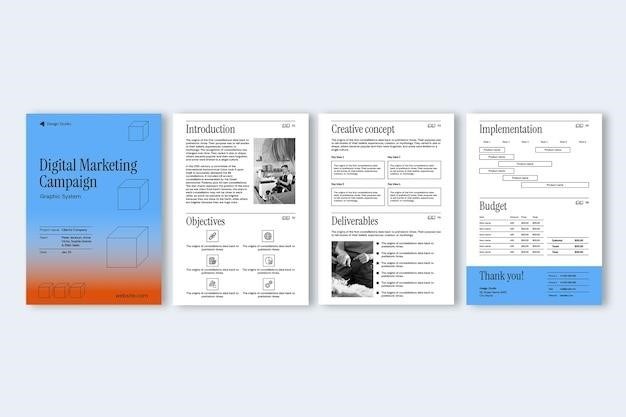blueberries for sal pdf
Blueberries for Sal: A Comprehensive Overview
Robert McCloskey’s “Blueberries for Sal,” published in 1948, remains a beloved classic. This timeless children’s book tells the story of Little Sal and her mother as they venture to Blueberry Hill to pick blueberries for winter canning, and their adventures with a bear family.
“Blueberries for Sal,” a cherished children’s picture book penned and illustrated by Robert McCloskey, first graced bookshelves in 1948, quickly establishing itself as a timeless classic. Set against the backdrop of Maine’s Blueberry Hill, the story introduces readers to Little Sal, a curious young girl, and a bear cub, both embarking on berry-picking expeditions with their mothers before the onset of winter.
McCloskey’s narrative gently unfolds the parallel adventures of these two families, highlighting themes of family, curiosity, and nature’s beauty. The book’s enduring appeal lies in its simple yet engaging storytelling and charming illustrations, making it a staple for bedtime reading and shared reading experiences. “Blueberries for Sal” reflects a nostalgic era, reminiscent of self-sufficiency and family traditions. The story’s balance of laughter and heart creates a comforting experience that resonates with readers of all ages, solidifying its place as a literary treasure. The book also received a Caldecott Honor in 1949.
Plot Summary and Main Characters
“Blueberries for Sal” follows Little Sal and her mother as they head to Blueberry Hill, laden with pails, to gather blueberries for canning, ensuring they have food for the winter. Simultaneously, on the other side of the hill, a mother bear and her cub, Little Bear, are also busy eating blueberries to store up fat for the approaching cold season.
The story unfolds as Sal and Little Bear wander off, each following their curiosity, eventually ending up trailing the wrong mother. This mix-up leads to humorous and heartwarming moments as both mothers realize the mistake and reunite with their own offspring. The main characters include Little Sal, an inquisitive and adventurous young girl; her caring and attentive Mother; Little Bear, a playful and curious bear cub; and his protective Mother Bear. The plot revolves around their parallel journeys, emphasizing the universal themes of family bonds and the innocent exploration of childhood.
Themes and Literary Significance
“Blueberries for Sal” explores several significant themes, most notably the bond between mother and child. The parallel stories of Sal and Little Bear highlight the universal nature of maternal love and the instinct to protect and care for one’s young. The book also touches upon the theme of curiosity and exploration, as both Sal and Little Bear wander off, driven by their inquisitive natures, leading to unexpected adventures.

The literary significance of “Blueberries for Sal” lies in its simple yet engaging storytelling, capturing the imagination and hearts of young readers. McCloskey’s writing style is gentle and rhythmic, creating a soothing reading experience. The book’s enduring appeal is also attributed to its realistic portrayal of childhood and its celebration of nature. It subtly reflects the values of thrift and resourcefulness, reminiscent of a time when families relied on preserving food for the winter. The story intricately balances laughter and heart, making it a story that readers will return to again and again.
Historical Context and Publication
“Blueberries for Sal” was published in 1948, a period of transition in the United States following World War II. The book subtly reflects the lingering values of thrift and self-sufficiency that were prominent during the Great Depression and the war years. The practice of canning and preserving food, as depicted in the story, was a common way for families to prepare for the winter months. This was before the shift towards store-bought goods that became more prevalent in the 1950s.
Robert McCloskey’s decision to set the story in Maine, with its picturesque landscapes and abundant blueberry crops, adds to the book’s charm and authenticity. The book’s publication also came at a time when children’s literature was gaining more recognition as an important genre. “Blueberries for Sal” quickly became a success, earning a Caldecott Honor in 1949, solidifying its place as a significant contribution to children’s literature. Its enduring popularity speaks to its timeless themes and its ability to connect with readers across generations.
Robert McCloskey: Author and Illustrator
Robert McCloskey (1914-2003) was a celebrated American author and illustrator, renowned for his contributions to children’s literature. He was a two-time Caldecott Medal winner, first for “Make Way for Ducklings” in 1942 and later for “Time of Wonder” in 1958, showcasing his exceptional talent in both writing and illustrating engaging stories for young readers. His unique style often incorporated detailed and realistic illustrations, bringing his characters and settings to life.
McCloskey’s personal experiences and surroundings frequently served as inspiration for his books. Having spent time in Maine, he was able to capture the essence of the region’s natural beauty and way of life in “Blueberries for Sal.” His ability to create relatable characters and heartwarming narratives, combined with his artistic skill, made him a beloved figure in the world of children’s literature. McCloskey’s legacy continues to inspire new generations of readers and illustrators alike.
“Blueberries for Sal” as a Caldecott Honor Book
“Blueberries for Sal” received the Caldecott Honor in 1949, a prestigious recognition awarded by the American Library Association to the most distinguished American picture books for children. This accolade underscores the book’s exceptional artistic merit and its significant contribution to children’s literature. The Caldecott Honor signifies that “Blueberries for Sal” stands out for its quality of illustration, artistic technique, and overall visual presentation, solidifying its place as a noteworthy work in the field.
The illustrations in “Blueberries for Sal,” created by Robert McCloskey, are integral to the story’s charm and enduring appeal. His use of simple yet expressive drawings effectively captures the characters’ emotions and the beauty of the Maine landscape; The Caldecott Honor acknowledges McCloskey’s skill in using illustrations to enhance the narrative and create a captivating reading experience for children. The award further cemented the book’s reputation and ensured its continued popularity among readers and educators.
Educational Value and Reading Activities
“Blueberries for Sal” offers significant educational value for young readers, extending beyond simple entertainment. The story subtly introduces children to concepts of nature, such as blueberry picking and animal behaviors, fostering an appreciation for the natural world. It also provides a glimpse into a bygone era of thrift and self-sufficiency, where families engaged in activities like canning to prepare for the winter months, promoting awareness of historical practices.
The book’s simple language and engaging narrative make it ideal for shared reading activities. Educators and parents can use “Blueberries for Sal” to enhance vocabulary, encourage comprehension, and promote discussions about family relationships, safety, and the importance of following directions. Furthermore, the story can inspire creative activities such as drawing, painting, or even a mock blueberry-picking excursion, allowing children to connect with the story on a deeper, more interactive level. Such activities can stimulate imagination and reinforce the book’s themes.
Comparison to Other Children’s Literature
“Blueberries for Sal” distinguishes itself from many other children’s books through its gentle pacing and focus on everyday experiences. Unlike fantastical tales filled with magical creatures or grand adventures, McCloskey’s story centers on a simple outing for blueberry picking, making it relatable to young readers. The book shares similarities with other stories that celebrate nature and family, such as “Make Way for Ducklings,” also by McCloskey, in its realistic portrayal of wildlife and familial bonds.

However, “Blueberries for Sal” stands apart from more didactic or moralistic children’s literature. It avoids overt lessons, instead allowing children to glean insights about nature, safety, and family through the unfolding narrative. Compared to more contemporary children’s books that often feature fast-paced plots and vibrant, digitally enhanced illustrations, “Blueberries for Sal” offers a more serene and understated reading experience. The book’s enduring appeal lies in its ability to capture the wonder of childhood and the simple joys of nature in a timeless and heartwarming way, setting it apart from trend-driven literature.

Legacy and Enduring Appeal
“Blueberries for Sal” has secured its place as a timeless classic in children’s literature, captivating generations of readers with its heartwarming story and charming illustrations. Its enduring appeal lies in its ability to resonate with both children and adults, evoking a sense of nostalgia and reminding readers of the simple joys of childhood. The book’s gentle narrative and relatable characters create a comforting and familiar experience, making it a favorite for bedtime reading and shared family moments.

The legacy of “Blueberries for Sal” extends beyond its literary merit. It has inspired countless adaptations, including films and stage productions, further solidifying its cultural significance. Moreover, the book’s themes of family, nature, and curiosity continue to resonate with contemporary audiences, making it a valuable tool for educators and parents alike. “Blueberries for Sal” remains a testament to the power of storytelling, demonstrating how a simple tale can capture the hearts and imaginations of readers for generations to come, ensuring its continued presence in children’s libraries and homes worldwide.


















